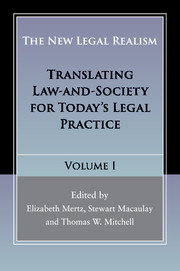Book contents
- Frontmatter
- Contents
- List of contributors
- Preface to The New Legal Realism, Volumes I and II
- 1 Introduction: New Legal Realism: Law and Social Science in the New Millennium
- Section I THE PLACE OF NEW LEGAL REALISM IN LEGAL THOUGHT AND TEACHING
- Section II PHILOSOPHY AND METHODS FOR A NEW LEGAL REALISM
- Section III NEW LEGAL REALIST TRANSLATIONS
- 10 New Legal Realism and Inequality
- 11 The Financial Crisis and Moral Accountability: Translating Practices of Risk, Profit, and Uncertainty
- 12 The Moment of Possibles: Some New Legal Realism about a “Reality Thriller” Case
- 13 Translating Law across Cultures and Societies: A Conversation with David Bellos and Kim Lane Scheppele
- 14 Is There a Lingua Franca for the American Legal Academy?
- Index
- References
10 - New Legal Realism and Inequality
from Section III - NEW LEGAL REALIST TRANSLATIONS
Published online by Cambridge University Press: 05 May 2016
- Frontmatter
- Contents
- List of contributors
- Preface to The New Legal Realism, Volumes I and II
- 1 Introduction: New Legal Realism: Law and Social Science in the New Millennium
- Section I THE PLACE OF NEW LEGAL REALISM IN LEGAL THOUGHT AND TEACHING
- Section II PHILOSOPHY AND METHODS FOR A NEW LEGAL REALISM
- Section III NEW LEGAL REALIST TRANSLATIONS
- 10 New Legal Realism and Inequality
- 11 The Financial Crisis and Moral Accountability: Translating Practices of Risk, Profit, and Uncertainty
- 12 The Moment of Possibles: Some New Legal Realism about a “Reality Thriller” Case
- 13 Translating Law across Cultures and Societies: A Conversation with David Bellos and Kim Lane Scheppele
- 14 Is There a Lingua Franca for the American Legal Academy?
- Index
- References
Summary
INTRODUCTION
Poor and minority property owners have lost millions of acres of land over the past 150 years, and much of this land loss has been involuntary. This history of land loss within minority communities had not received a great deal of popular attention at the national level until the late 1990s and early 2000s. However, after African-American farmers filed a class action lawsuit against the United States Department of Agriculture (USDA) in 1997 claiming that the USDA had systematically discriminated against black farmers for decades, other groups of farmers, including Latino and Native American farmers, filed discrimination claims against the USDA as well (Mitchell, Malpezzi, and Green 2010, 656).
One of the central claims the plaintiffs in all of these lawsuits made was that the USDA had discriminated against minority farmers in how it handled loans and in how it administered certain agricultural benefit programs. The USDA discrimination in fact led to significant loss of land among the impacted minority farmers, mostly as a result of foreclosure sales that occurred when loan applications were improperly denied or were approved in a very untimely way in comparison to how the USDA processed loan applications from white farmers. Further, as a result of the black farmers’ lawsuit, many in the media reported on the demise of black farmers in general – and some also reported on the plight of other minority farmers. In addition, some in the media also started reporting more generally on the phenomenon of land loss among African-American landowners – in particular, land loss that was attributable to either discrimination or at least to very underhanded, if technically legal, practices (Mitchell 2005, 567). Though the media correctly reported that African-Americans had lost millions of acres of property over the course of several decades, the reporters did not argue that black landowners as a whole were destined to lose all their remaining property, although many reported that the subset of black landowners who were also farmers was in danger of becoming extinct (as some others had been warning for quite some time).
Media coverage of land loss within the African-American community revealed that some legal scholars had identified a small number of legal processes that a range of public and private actors have used to force the sale of black-owned land over the course of several decades.
- Type
- Chapter
- Information
- The New Legal RealismTranslating Law-and-Society for Today's Legal Practice, pp. 203 - 222Publisher: Cambridge University PressPrint publication year: 2016



